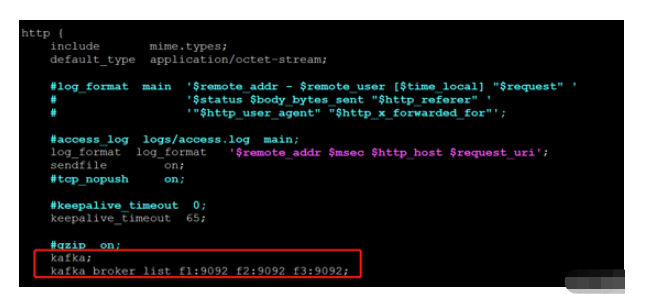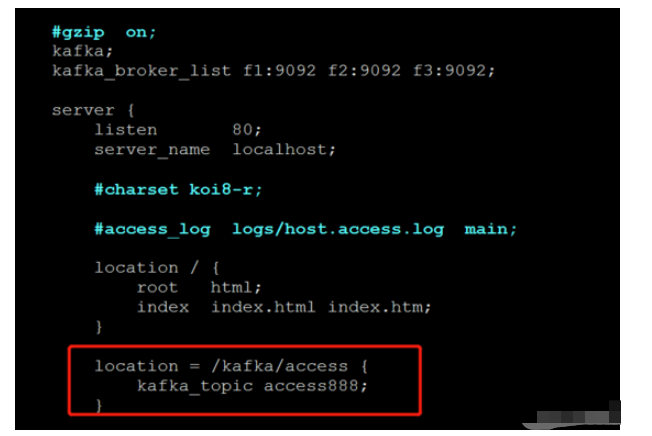How to integrate Kafka with Nginx
Background
nginx-kafka-module is a plug-in for nginx. It can integrate kafka into nginx to facilitate the collection of front-end page buried point data in web projects. If the front-end page has set buried points, that is Some of the user's access and request data can be sent directly to the message middleware kafka through http requests. The backend can consume the messages in kafka through the program to perform real-time calculations. For example, sparkstream is used to consume data in Kafka in real time to analyze user pv, uv, some user behaviors and the funnel model conversion rate of the page, so as to better optimize the system or conduct real-time dynamic analysis of visiting users.
Specific integration steps
1. Install git
yum install -y git
2. Switch to the /usr/local/src directory, and then clone the kafka c client source code Go to local
cd /usr/local/src git clone https://github.com/edenhill/librdkafka
3. Enter librdkafka, and then compile it
cd librdkafka yum install -y gcc gcc-c++ pcre-devel zlib-devel ./configure make && make install
4. Install nginx integration kafka plug-in, enter /usr/local/src, clone nginx integrates the source code of kafka
cd /usr/local/src git clone https://github.com/brg-liuwei/ngx_kafka_module
5. Enter the nginx source package directory (compile nginx, and then compile the plug-in at the same time)
cd /usr/local/src/nginx-1.12.2 ./configure --add-module=/usr/local/src/ngx_kafka_module/ make && make install
6. Modify nginx Configuration file: Set a location and kafaka topic
#添加配置(2处)
kafka;
kafka_broker_list f1:9092 f2:9092 f3:9092;
location = /kafka/access {
kafka_topic access888;
}as shown below:


7. Start zk and kafka clusters (create topic)
zkserver.sh start kafka-server-start.sh -daemon config/server.properties
8. Start nginx and report an error. The file kafka.so.1 cannot be found
##9. Loading so libraryerror while loading shared libraries: librdkafka.so.1: cannot open shared object file: no such file or directory
#开机加载/usr/local/lib下面的库 echo "/usr/local/lib" >> /etc/ld.so.conf #手动加载 ldconfig
curl http://localhost/kafka/access -d "message send to kafka topic" curl http://localhost/kafka/access -d "小伟666"测试


The above is the detailed content of How to integrate Kafka with Nginx. For more information, please follow other related articles on the PHP Chinese website!

Hot AI Tools

Undresser.AI Undress
AI-powered app for creating realistic nude photos

AI Clothes Remover
Online AI tool for removing clothes from photos.

Undress AI Tool
Undress images for free

Clothoff.io
AI clothes remover

Video Face Swap
Swap faces in any video effortlessly with our completely free AI face swap tool!

Hot Article

Hot Tools

Notepad++7.3.1
Easy-to-use and free code editor

SublimeText3 Chinese version
Chinese version, very easy to use

Zend Studio 13.0.1
Powerful PHP integrated development environment

Dreamweaver CS6
Visual web development tools

SublimeText3 Mac version
God-level code editing software (SublimeText3)

Hot Topics
 1386
1386
 52
52
 How to configure cloud server domain name in nginx
Apr 14, 2025 pm 12:18 PM
How to configure cloud server domain name in nginx
Apr 14, 2025 pm 12:18 PM
How to configure an Nginx domain name on a cloud server: Create an A record pointing to the public IP address of the cloud server. Add virtual host blocks in the Nginx configuration file, specifying the listening port, domain name, and website root directory. Restart Nginx to apply the changes. Access the domain name test configuration. Other notes: Install the SSL certificate to enable HTTPS, ensure that the firewall allows port 80 traffic, and wait for DNS resolution to take effect.
 How to check whether nginx is started
Apr 14, 2025 pm 01:03 PM
How to check whether nginx is started
Apr 14, 2025 pm 01:03 PM
How to confirm whether Nginx is started: 1. Use the command line: systemctl status nginx (Linux/Unix), netstat -ano | findstr 80 (Windows); 2. Check whether port 80 is open; 3. Check the Nginx startup message in the system log; 4. Use third-party tools, such as Nagios, Zabbix, and Icinga.
 How to check nginx version
Apr 14, 2025 am 11:57 AM
How to check nginx version
Apr 14, 2025 am 11:57 AM
The methods that can query the Nginx version are: use the nginx -v command; view the version directive in the nginx.conf file; open the Nginx error page and view the page title.
 How to create a mirror in docker
Apr 15, 2025 am 11:27 AM
How to create a mirror in docker
Apr 15, 2025 am 11:27 AM
Steps to create a Docker image: Write a Dockerfile that contains the build instructions. Build the image in the terminal, using the docker build command. Tag the image and assign names and tags using the docker tag command.
 How to start nginx server
Apr 14, 2025 pm 12:27 PM
How to start nginx server
Apr 14, 2025 pm 12:27 PM
Starting an Nginx server requires different steps according to different operating systems: Linux/Unix system: Install the Nginx package (for example, using apt-get or yum). Use systemctl to start an Nginx service (for example, sudo systemctl start nginx). Windows system: Download and install Windows binary files. Start Nginx using the nginx.exe executable (for example, nginx.exe -c conf\nginx.conf). No matter which operating system you use, you can access the server IP
 How to check whether nginx is started?
Apr 14, 2025 pm 12:48 PM
How to check whether nginx is started?
Apr 14, 2025 pm 12:48 PM
In Linux, use the following command to check whether Nginx is started: systemctl status nginx judges based on the command output: If "Active: active (running)" is displayed, Nginx is started. If "Active: inactive (dead)" is displayed, Nginx is stopped.
 How to start nginx in Linux
Apr 14, 2025 pm 12:51 PM
How to start nginx in Linux
Apr 14, 2025 pm 12:51 PM
Steps to start Nginx in Linux: Check whether Nginx is installed. Use systemctl start nginx to start the Nginx service. Use systemctl enable nginx to enable automatic startup of Nginx at system startup. Use systemctl status nginx to verify that the startup is successful. Visit http://localhost in a web browser to view the default welcome page.
 How to run nginx apache
Apr 14, 2025 pm 12:33 PM
How to run nginx apache
Apr 14, 2025 pm 12:33 PM
To get Nginx to run Apache, you need to: 1. Install Nginx and Apache; 2. Configure the Nginx agent; 3. Start Nginx and Apache; 4. Test the configuration to ensure that you can see Apache content after accessing the domain name. In addition, you need to pay attention to other matters such as port number matching, virtual host configuration, and SSL/TLS settings.




